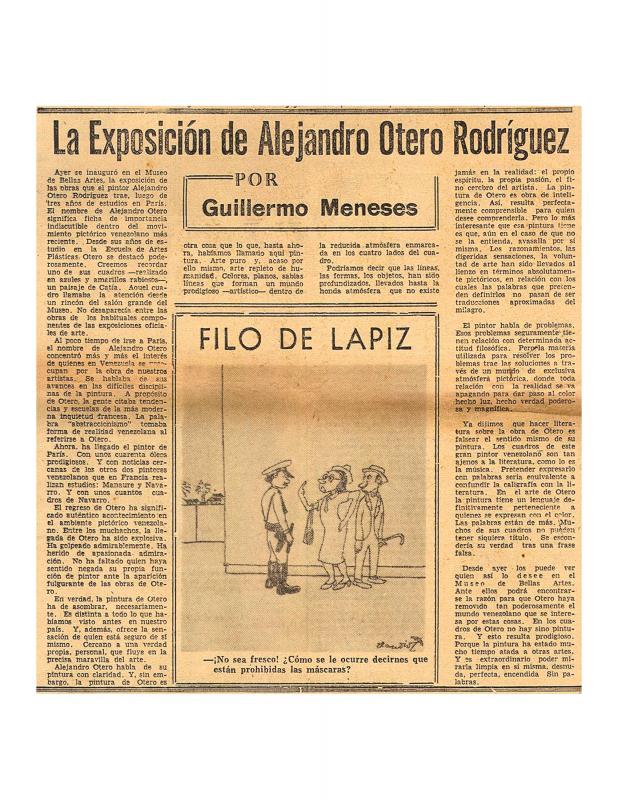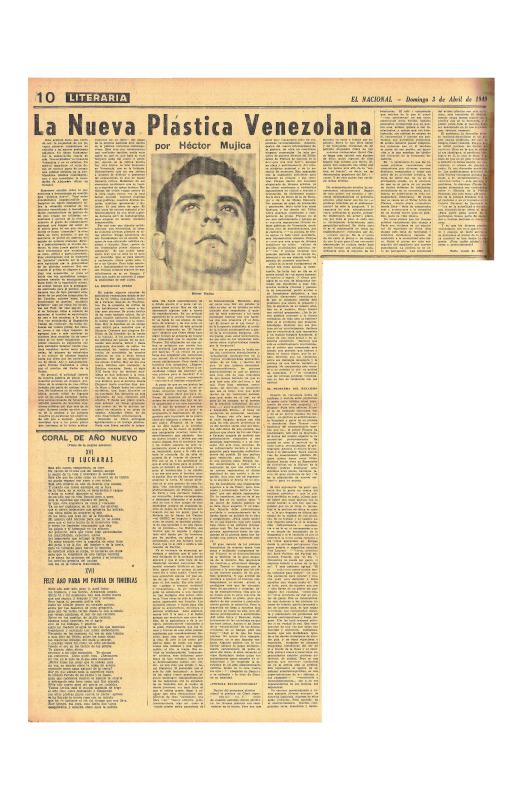In the exhibition at the Museo de Bellas Artes de Caracas (January 30, 1949), which the journalist José Ratto-Ciarlo reviews, the artist Alejandro Otero exhibits his series Las Cafeteras through which he singlehandedly inaugurated abstract art in Venezuelan art. A few months later, the exhibition sparked polarized discussions critical of Otero by some of the social realists representing the movement. The review is of interest because in avoiding a controversial tone, Ratto-Ciarlo presents his own views and those of others, accompanied with the brief interviews he does with visitors to the exhibition from the floor of the galleries, opening the discussion, both for and against what Otero is proposing. Yet, Ratto-Ciarlo’s opinions on the artist and his works are contradictory. Despite asserting that his critique is not negative, when analyzing the exhibited “Tela Nº IX”of the series, he comments that it will be released from its “dubious label,” engaging in a symbolic and figurative subjective interpretation far from anything proposed by the artist; he sees in his paintings “a subconscious horizon of a full storm that is in conflict with daylight, in front of which the mast of a hypothetical sailboat is vacillating, attracted by the beacon of the lighthouse in its attempt to reach to port.” Ratto-Ciarlo does not emphatically reject the work, instead he pretends to analyze it and in doing so he conveys confusion to the readers. In his view, Otero is going through an inner crisis that he may overcome since “he has not lost his purity nor the healthy lyricism affecting his vigorous temperament.”
Equally, the answers of the interviewees reveal misunderstandings and confusion, if not caution; including a clerk, a farmer, and an elementary schoolteacher whom “did not like” or could not understand the work. Also artists and intellectuals who were art connoisseurs (Mercedes Pardo de Bontá, whom later would become Otero’s wife), and the director of the Museum of Fine Arts, Carlos Otero were interviewed. Pardo, having difficulty making a statement, but not [with regard to] whether he likes the Cafeteras Rosa series, states: “we are in the world of abstract art. But while I do not believe in abstract art; I have faith in Otero, who is sedulously in search of himself.” In addition, this review is a testament to the minute receptiveness to change and the misinformation to the public attending the museums of Caracas in the mid-twentieth century; and at the same time, it illustrates the variety of the visitors and [whether they] their interest for visiting the Museum of Fine Arts.
[For other texts critiquing Otero’s work, consult the ICAA digital archives: by J. R. Guillent Pérez (another member of the group Los Disidentes), “Realidad e irrealidad: El postigo de Alejandro Otero” (doc. no. 1172158); by Guillermo Meneses, “La exposición de Alejandro Otero Rodríguez” (doc. no. 1097092); by Roberto Guevara, “La vertical vibrante de Maracay, 1968” (doc. no. 1168201); the text in the catalogue for the Alejandro Otero exhibition (1949) (doc. no. 850732); the article “La nueva plástica venezolana,” by Héctor Mujica (doc. no. 850512); the text by María Elena Ramos, “Alejandro Otero: indagar en las estructuras de la realidad” (doc. no. 1167733); the analysis by Ernesto Guevara, “Sólo quisiera ser puntual. El tiempo en la pintura de Alejandro Otero” (doc. no. 1163813); the essay by Damián Bayón, “El espacio dinámico en la obra de Alejandro Otero” (doc. no. 1167828); the texts by Juan Calzadilla, “Exposiciones en Caracas: Alejandro Otero-Galería Mendoza” (doc. no. 1172174) and “Alejandro Otero y la enseñanza del arte” (doc. no. 1167940); the article by Miguel Otero Silva, “Sobre unas declaraciones disidentes del pintor Alejandro Otero Rodríguez” (doc. no. 813737); and lastly, the review by Juan Carlos Palenzuela, “Una conciencia de arte latinoamericano” (doc. no. 1163142)].












